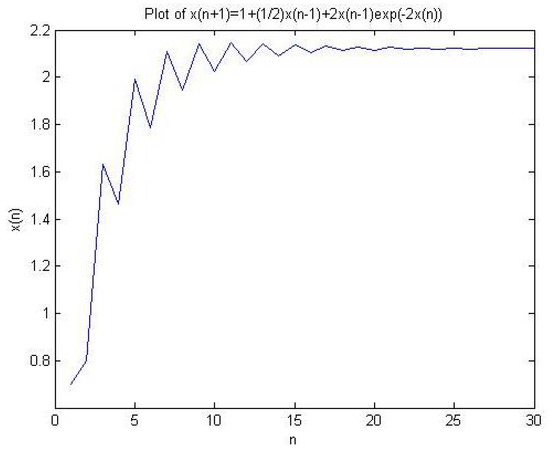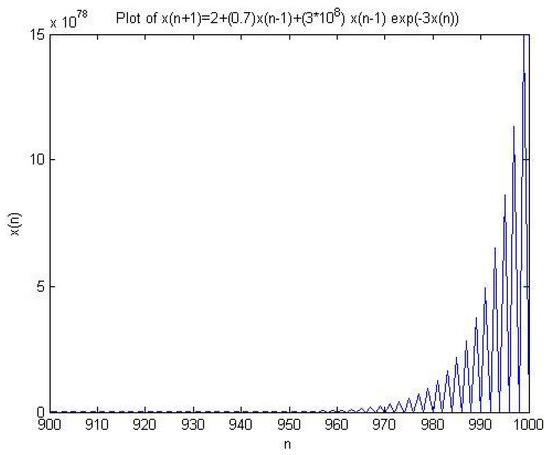Abstract
In this work, we explore the boundedness and local and global asymptotic behavior of the solutions to a second-order difference formula of the exponential type , where , and the initials are non-negative real numbers. Some other special cases are given. We provide two concrete numerical examples to confirm the theoretical results.
MSC:
39A11; 39A10
1. Introduction and Preliminaries
The study of non-linear difference formulas has sparked a lot of attention recently. The research of non-linear difference formulas brings considerable difficulty to mathematicians and is also extremely gratifying because of its great applications in various fields of applied as well as pure mathematics. This type of equation arises from probability theory, psychology, biology, population, genetics, economics, etc. For some papers in this direction, we refer to [1,2,3,4,5].
Exponential-type difference equations are among the most essential sorts of non-linear difference formulas. H. El-metwally et al. [6] examined the global stability of
where and the initials are positive real numbers. This formula might check out as a model, where c is the migration rate, and d is the population growth rate.
In [7], the global asymptotic stability of
is investigated where , and b are positive numbers.
Ding et al. [8] studied a discrete population equation in the form
where , , , .
The purpose of our work is to study the local behavior, boundedness, and behavior of difference formula in the exponential type
where , and the initials are positive real numbers.
For even more results of the exponential-type difference formulas and related results, we refer the reader to [9,10,11,12,13,14,15,16,17].
For some outcomes of the systems of exponential-type difference formulas, we can see [1,18,19].
Let J be an interval in and be a continuous function.
Consider
where the initials .
The linearized equation in Equation (2) about the equilibrium is
where , are the partial derivatives of at of Equation (2).
The following theorem is an essential tool to determine the local asymptotic stability of .
Theorem 1
(Linearized stability theorem) (see [14]).
- (i)
- (ii)
- A sufficient and necessary condition for both roots of Equation (4) to have an absolute value less than one is
- (iii)
- (iv)
- A sufficient and necessary condition for one root of Equation (4) to have an absolute value less than one and the other root of Equation (4) to have an absolute value greater than one isSo, is called a saddle-point equilibrium.
Theorem 2
(A comparison theorem) (see [20]). Let and . Let and be sequences in provided that , and ,. Then, for .
The following important theorem is the primary tool to study the convergence of solutions to Equation (2).
Theorem 3
(see [14]). Suppose:
- (i)
- There are positive numbers s and t with such that for all .
- (ii)
- is decreasing in for each , and is increasing in for each .
- (iii)
2. Local Asymptotic Stability Analysis
In this section, we study the existence of a unique equilibrium and the local asymptotic stability of solutions.
The equilibriums of Equation (1) are the solutions to
Set
Then, , and .
Moreover,
This means that Equation (5) has exactly one solution , and, furthermore, .
Theorem 4.
Suppose that
Proof.
The linearized equation of Equation (1) about is
The characteristic equation is
By using Theorem 1, we see that is locally asymptotically stable if
Corollary 1.
If
then is unstable.
Remark 1.
We note that is a saddle point.
3. Boundedness of Solutions
We establish a suitable condition for the boundedness of solutions.
Theorem 5.
Proof.
Let be a solution to Equation (1). For all ,
Now, we consider the equation
Corollary 2.
4. Global Asymptotic Stability Analysis
We derive the suitable condition in which the of Equation (1) is globally asymptotically stable.
Theorem 6.
Proof.
Let with
We will show that .
Now, we note that
and
So,
Set
Clearly, . We will show has exactly one z-intercept greater than .
Let be such that . We shall try to show that . Now,
As , we have
So,
if and only if
For , set
and
Now,
Moreover,
By using Inequality (11), we have .
Now,
From the above, we can see that . □
Theorem 7.
Suppose
Proof.
We have
By Theorem 4, we see that is locally asymptotically stable. We shall show that there exist positive numbers s and t with provided that for all and that every positive solution of Equation (1) eventually lies in .
Let be given, and set
Moreover,
Hence is decreasing in and increasing in . So, for all . Now, clearly every positive solution of Equation (1) is eventually greater than and is eventually less than .
Thus, the proof follows by Theorems 3 and 6. □
5. Some Special Cases
In this section, we formulate the local asymptotic stability condition, boundedness condition, global asymptotic stability condition of some special cases of Equation (1) in Table 1.

Table 1.
LASC, BC, and GASC of some special cases of Equation (1).
6. Numerical Examples
In this section, we give some numerical examples for validating the outcomes of previous sections.
Example 1.

We let , , , , and . So, we deal with the equation
We find that

Figure 1.
Plot of Example (1).
7. Conclusions
We investigate the boundedness, local actions, and global asymptotic behavior of the solutions to the second-order difference equation of the exponential type
where , and the initials are non-negative real numbers. Our results generalized the results in [6]. We gave two concrete numerical examples to confirm the theoretical results.
Author Contributions
Conceptualization, T.F.I. and A.Q.K.; methodology, T.F.I. and A.Q.K.; software, T.F.I. and M.A.E.-M.; validation, T.F.I. and M.A.E.-M.; formal analysis, T.F.I. and A.Q.K.; investigation, T.F.I. and A.Q.K.; resources, T.F.I., M.A.E.-M. and F.M.A.; data curation, T.F.I., M.A.E.-M. and F.M.A.; writing—original draft preparation, T.F.I., M.A.E.-M. and F.M.A.; writing—review and editing, T.F.I., M.A.E.-M. and F.M.A.; visualization, T.F.I.; supervision, T.F.I. and A.Q.K.; project administration, T.F.I.; funding acquisition, T.F.I. All authors have read and agreed to the published version of the manuscript.
Funding
King Khalid University (project under grant number RGP.2/47/43/1443).
Institutional Review Board Statement
Not applicable.
Informed Consent Statement
Not applicable.
Data Availability Statement
All essential information used in this article is included, and we draw on resources as needed.
Acknowledgments
We would like to thank the reviewers for their helpful comments that improved the article. The authors extend their appreciation to the Deanship for Scientific Research at King Khalid University for funding this work through Larg groups (project under grant number RGP.2/47/43/1443).
Conflicts of Interest
There is no conflict of interest regarding the publication of our work.
References
- Ibrahim, T.F. Asymptotic behavior of a difference equation model in exponential form. Appear Math. Methods Appl. Sci. 2022. [Google Scholar] [CrossRef]
- Ibrahim, T.F.; Nurkanovic, Z. Kolmogorov-Arnold-Moser theory and symmetries for a polynomial quadratic second order difference equation. Mathematics 2019, 7, 790. [Google Scholar] [CrossRef]
- Ibrahim, T.F. Bifurcation and Periodically Semicycles for Fractional Difference Equation of fifth-order. J. Nonlinear Sci. Appl. 2018, 11, 375–382. [Google Scholar] [CrossRef]
- Ibrahim, T.F.; El-Moneam, M.A. Global stability of a higher-order difference equation. Iran. J. Sci. Technol. Trans. A Sci. 2017, 41, 51–58. [Google Scholar] [CrossRef]
- Ibrahim, T.F. Periodicity and Global Attractivity of Difference Equation of Higher-Order. J. Comput. Anal. Appl. 2014, 16, 552–564. [Google Scholar]
- El-Metwally, E.; Grove, E.A.; Ladas, G.; Levins, R.; Radin, M. On the difference equation ξn+1 = a + bξn−1e−ξn. Nonlinear Anal. 2001, 47, 4623–4634. [Google Scholar] [CrossRef]
- Ozturk, I.; Bozkurt, F.; Ozen, S. On the difference equation Appl. Math. Comput. 2006, 181, 1387–1393. [Google Scholar] [CrossRef]
- Ding, X.; Zhang, R. On the difference equation ξn+1 = (aξn + bξn−1)e−ξn. Adv. Differ. Equa. 2008, 2008, 876936. [Google Scholar]
- Gocen, M. On some difference equations of exponential form. Karaelmas Sci. Eng. J. 2018, 8, 581–584. [Google Scholar]
- Bo, Y.; Tian, D.; X, L.; Jin, Y.F. Discrete maximum principle and energy stability of the compact difference scheme for two-dimensional Allen-Cahn equation. J. Funct. Spaces 2022, 2022, 8522231. [Google Scholar] [CrossRef]
- Bozkurt, F. Stability analysis of a nonlinear difference equation. Int. Mod. Nonlinear Theory Appl. 2013, 2, 1–6. [Google Scholar] [CrossRef]
- Comert, T.; Yalcinkaya, I.; Tollu, D.T. A study on the positive solutions of an exponential type difference equation. Electron. Math. Anal. Appl. 2018, 6, 276–286. [Google Scholar]
- Feng, H.; Ma, H.; Ding, W. Global asymptotic behavior of positive solutions for exponential form difference equations with three parameters. Appl. Anal. Comput. 2016, 6, 600–606. [Google Scholar]
- Fotiades, N.; Papaschinopulos, G. Existence, uniqueness, and attractivity of prime period two solution for a difference equation of exponential form. Math. Comput. Model. 2012, 218, 11648–11653. [Google Scholar] [CrossRef]
- Khalsaraei, M.M.; Shokri, A.; Noeiaghdam, S.; Molayi, M. Nonstandard finite difference schemes for an SIR epidemic model. Mathematics 2021, 9, 23. [Google Scholar] [CrossRef]
- Ozturk, I.; Bozkurt, F.; Ozen, S. Global asymptotic behavior of the difference equation . Appl. Math. Lett. 2009, 22, 595–599. [Google Scholar] [CrossRef]
- Ragusa, M.A. Parabolic Herz spaces and their applications. Appl. Math. Lett. 2012, 25, 1270–1273. [Google Scholar] [CrossRef]
- Khan, A.Q.; Qureshi, M.N. Stability analysis of a discrete biological model. Int. J. Biomath. 2016, 9, 1650021. [Google Scholar] [CrossRef]
- Psarros, N.; Papaschinopoulos, G.; Papadopoulos, K.B. Long-term behavior of positive solutions of an exponentially self-regulating system of difference equations. Int. J. Biomath. 2017, 10, 1750045. [Google Scholar] [CrossRef]
- Kocic, V.L.; Ladas, G. Global Behavior of Nonlinear Difference Equations of Higher Order with Applications; Mathematics and Its Applications; Kluwer Academic Publishers: Dordrecht, The Netherlands, 1993; Volume 256. [Google Scholar]
Publisher’s Note: MDPI stays neutral with regard to jurisdictional claims in published maps and institutional affiliations. |
© 2022 by the authors. Licensee MDPI, Basel, Switzerland. This article is an open access article distributed under the terms and conditions of the Creative Commons Attribution (CC BY) license (https://creativecommons.org/licenses/by/4.0/).
